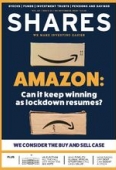Archived article
Please note that tax, investment, pension and ISA rules can change and the information and any views contained in this article may now be inaccurate.
Why it helps if chip stocks show some sizzle

The heavyweight sextet of Alphabet, Amazon, Apple, Facebook, Microsoft and Netflix are not the only names that matter in the broad technology sector. Granted, Amazon and Apple are among the 20 best performers in America’s benchmark S&P 500 index so far this year, but so are several other tech or tech-related firms, notably silicon chip makers Nvidia and Advanced Micro Devices.
This is a marked contrast to the woes of the oil sector, which provides no less than 12 of the 20 worst performers in the S&P 500.
That will not stun too many investors after the oil price’s swan dive, and the strong showing of silicon chip stocks should not be such a surprise in some ways either. After all, the semiconductor industry is worth over $400 billion in annual sales and not one of smart phones, cars, computers, servers, smart meters or anything else electronic you can think of can function without them.
The importance of the semiconductor industry is evidenced by how it can point to a compound annual sales growth rate of 8% over the past 40 years, albeit with some big swings and roundabouts along the way.
As a result, investors should really pay attention, although it is not easy to do this through the lens of the UK stock market, which is all the poorer for the disappearance over time of ARM, ARC, CSR Imagination, PureWafer and Wolfson. IQE (IQE:AIM) is one of the few listed players relevant to this space left on the UK market.
Investors must look Stateside for their fill of chip stocks and the Philadelphia Semiconductor index, or SOX, means this can be done with ease. All but of a couple of the benchmark index’s 30 members hail from the US and it can be tracked for free on the internet.
Scratch and sniff
As a scratch-and-sniff test, the SOX has two uses. The first is as a barometer for economic activity.
The sheer ubiquity of silicon chips means they are a fair proxy for economic growth and broader end-market demand.
A consensus forecast of 5% sales growth in 2020 looks good given the broader economic backdrop and is testimony to how chip sales are getting a boost from the pandemic, thanks to higher demand for servers and cloud computing capacity, bandwidth-providing telecoms equipment and laptops and home computing.
Beyond such mega trends, the members of the SOX index are driven by product and inventory cycles – their order books will be among the first to notice any subtle shifts in customer behaviour which may be indicative of a wider economic trend that is coming around the corner in a few months’ time.
The second is as a guide to market risk appetite. Chip stocks are traded as momentum and growth stocks, doing well when earnings estimates are going up and badly when they are going down. In addition, the SOX can be fair guide to stock markets more generally. The index peaked before the wider US stock market in both 2000 and 2007; and bottomed before headline indices such as the S&P 500 began to find their footing in 2002 and 2009.
Corporate conundrum
The SOX has had a stunning run in 2020, reaching a new record high, to further exemplify how financial markets have feasted off central banks’ monetary stimulus, fed off hopes for fresh fiscal stimulus and sought to peer through the pandemic to an eventual economic upturn.
Yet the indicator has just rolled over in the past month or so, weighed down by cautious comments from leading constituents such as Intel and Micron, as well as Asian chip-making giant Samsung. All three cited weaker future demand for servers thanks to an inventory pile-up.
Coming after gloomy commentary from Cisco, IBM and German enterprise software specialist SAP, all of whom flagged growing corporate caution when it came to spending money, there is perhaps a growing danger of a double-dip recession as companies cut back even further due to the uncertain outlook.
It is not just corporate tools which contain silicon chips, but consumer gadgets too, so as we head into the Christmas selling season it will be interesting to see if the SOX starts to sag or whether it can maintain this year’s strong run. It is always possible that dramatic further action from central banks renders such fundamental analysis largely irrelevant, at least when it comes to share prices.
Important information:
These articles are provided by Shares magazine which is published by AJ Bell Media, a part of AJ Bell. Shares is not written by AJ Bell.
Shares is provided for your general information and use and is not a personal recommendation to invest. It is not intended to be relied upon by you in making or not making any investment decisions. The investments referred to in these articles will not be suitable for all investors. If in doubt please seek appropriate independent financial advice.
Investors acting on the information in these articles do so at their own risk and AJ Bell Media and its staff do not accept liability for losses suffered by investors as a result of their investment decisions.

 magazine
magazine











